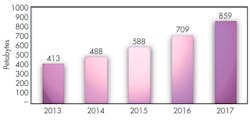If you think Big Brother can see you better than ever before, you aren’t wrong. Each day, surveillance cameras around the world produce 413 petabytes of data, according to IHS Inc. That’s enough information to fill 92.1 million single-sided, single-layer DVDs.
Related Articles
- Smarter Video Surveillance Requires The Right Hardware And Software
- Design FAQ: IP Video Surveillance
- Basics Of Design: Adaptive Equalization For Surveillance Video
New high-definition video cameras now entering the marketing are driving this total, which IHS expects to double in four years to 859 petabytes by 2017. In turn, technologies that can handle and process big data will grow as well, the company predicts.
“These cameras are gaining acceptance because the quality of their video can be superior to standard-resolution products that formerly dominated the market,” said Sam Grinter, senior surveillance analyst at IHS. “But because each HD camera produces far more data than each standard-definition camera, the quantity of data generated by the surveillance market is growing to massive proportions.”
Innovative technologies such as new compression algorithms will accommodate and mitigate this huge data increase. Also known as H.265, the High Efficiency Video Coding (HEVC) standard doubles the data compression ratio compared to H.264, reducing the amount of data produced per camera.
Also, video content analysis (VCA) can reduce the amount of time that a video camera records by using virtual tripwires and no-entry zones. These technologies can trigger cameras to record only when a predefined event has occurred, such as someone entering a parking lot, reducing the amount of data produced as well.
Finally, IHS expects hard-disk drives (HDDs) to play a role since their capacities continue to increase. While the amount of data produced per camera is expanding, so is the capacity to record that data, either on site or via networked systems.
For details, see the IHS report, “Enterprise and IP Storage used for Video Surveillance—World—2014” at www.imsresearch.com/report/enterprise_and_ip_storage_used_for_video_surveillance_world_2014.
